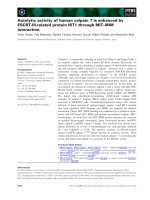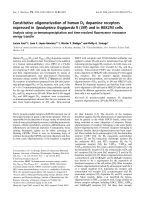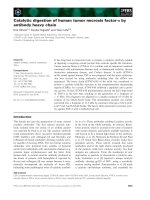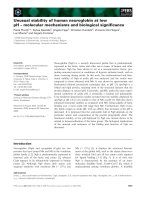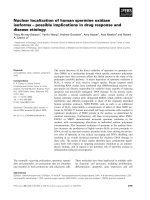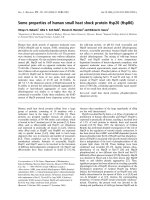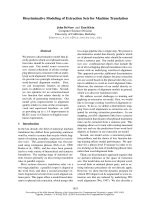Báo cáo khoa học: "Computational Modeling of Human Language Acquisition" ppt
Bạn đang xem bản rút gọn của tài liệu. Xem và tải ngay bản đầy đủ của tài liệu tại đây (57.17 KB, 1 trang )
Tutorial Abstracts of ACL-IJCNLP 2009, page 4,
Suntec, Singapore, 2 August 2009.
c
2009 ACL and AFNLP
Computational Modeling of Human Language Acquisition
Afra Alishahi
Department of Computational Linguistics and Phonetics
Saarland University, Germany
1 Introduction
The nature and amount of information needed
for learning a natural language, and the under-
lying mechanisms involved in this process, are
the subject of much debate: is it possible to
learn a language from usage data only, or some
sort of innate knowledge and/or bias is needed
to boost the process? This is a topic of inter-
est to (psycho)linguists who study human lan-
guage acquisition, as well as computational lin-
guists who develop the knowledge sources nec-
essary for largescale natural language process-
ing systems. Children are a source of inspira-
tion for any such study of language learnability.
They learn language with ease, and their acquired
knowledge of language is flexible and robust.
Human language acquisition has been studied
for centuries, but using computational modeling
for such studies is a relatively recent trend. How-
ever, computational approaches to language learn-
ing have become increasing popular, mainly due
to the advances in developing machine learning
techniques, and the availability of vast collections
of experimental data on child language learning
and child-adult interaction. Many of the existing
computational models attempt to study the com-
plex task of learning a language under the cogni-
tive plausibility criteria (such as memory and pro-
cessing limitations that humans face), as well as
to explain the developmental patterns observed in
children. Such computational studies can provide
insight into the plausible mechanisms involved in
human language acquisition, and be a source of
inspiration for developing better language models
and techniques.
2 Content Overview
This tutorial will discuss the main research ques-
tions that the researchers in the field of compu-
tational language acquisition are concerned with,
and will review common approaches and tech-
niques used in developing such models. Compu-
tational modeling has been vastly applied to dif-
ferent domains of language acquisition, including
word segmentation and phonology, morphology,
syntax, semantics and discourse. However, due to
time restrictions, the focus of the tutorial will be
on the acquisition of word meaning, syntax, and
the relationship between syntax and semantics.
The first part of the tutorial focuses on some of
the fundamental issues in the study of human lan-
guage acquisition, and the role of computational
modeling in addressing these issues. Specifically,
we discuss language modularity, i.e. the represen-
tation and acquisition of various aspects of lan-
guage, and the interaction between these aspects.
We also review the major arguments on language
learnability and innateness. We then give a general
overview of how computational modeling is used
for investigating different views on each of these
topics, how the theoretical assumptions are inte-
grated into computational models, and how such
models are evaluated based on the experimental
observations.
In the second part of the tutorial, we will take
a closer look at some of the existing models of
language learning. We discuss general trends in
computational modeling over the past decades, in-
cluding symbolic, connectionist, and probabilistic
modeling. We review a number of more influential
models of the acquisition of syntax and semantics,
and the link between the two. Finally, we explore
some of the available tools and resources for im-
plementing and evaluating computational models
of language acquisition.
4
